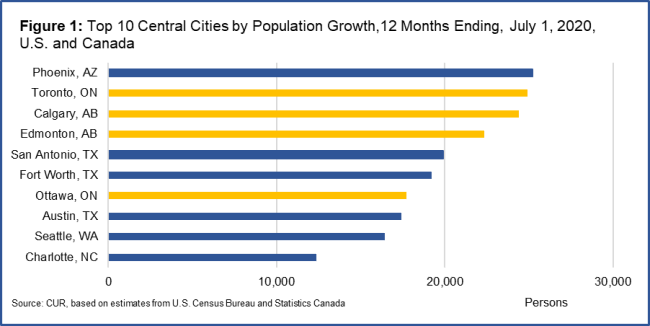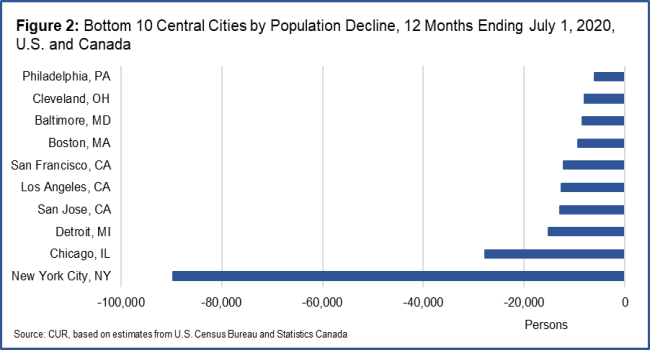The City of Toronto Now the Second Fastest Growing Among U.S. and Canadian Central Cities in 2020, Down from First Place in 2019
By: Frank Clayton, Diana Petramala and Ethan Crowe
June 16, 2021
(PDF file) Print-friendly version available
This blog is a follow-up to a recent CUR blog that ranked population growth among metropolitan areas in the United States and Canada. This blog now compares major central cities1 across the US and Canada. The Census Bureau in the United States has since released new population estimates for cities and towns (also known as municipalities). These population estimates are for the period ending July 1, 2020 and are comparable to the estimates for Canadian municipalities that Statistics Canada released in February.
This blog compares the growth in population in the 12 months ending July 1, 2020 in central cities in Canada with those south of the border. The data show that the city of Toronto’s ranking slipped to the second fastest-growing central city in Canada and the U.S., coming in behind Phoenix. The city of Toronto (Toronto) was the fastest-growing central city in both countries in 2018 and 2019.
Toronto was one of four Canadian central cities on the top ten list in terms of population growth in 2020, along with Calgary, Edmonton and Ottawa (Figure 1). Montreal slipped off the top 10 list of fastest growing cities, after ranking second in 2019.

Phoenix replaced Toronto as the fastest-growing central city in Canada and the U.S. in 2020. Other municipalities on the top ten list include San Antonio, Fort Worth, Austin and Seattle.
All ten of the largest declining central cities were in the U.S.
Big-name U.S. cities were among the central cities recording the most significant declines in population in the 12 months ending July 1, 2020 (Figure 2). New York City posted the biggest decline as was the case in 2019. Other central cities with sizable declines included Chicago, Detroit, San Jose, Los Angeles, and Boston.

Final Thoughts
With the exception of Toronto, most of the cities with the fastest growing populations also happen to have ample amount of land to build new low-rise homes. Calgary, Edmonton and Phoenix, in particular, have some land on the fringes, allowing them to grow out, rather than up.
Sources:
[1] A central city is a heavy populated area at the centre of a major metropolitan area. In Canada, central cities are defined by census subdivisions, which are also more commonly known as municipalities.
Frank Clayton is Senior Research Fellow at Toronto Metropolitan University’s Centre for Urban Research and Land Development (CUR) in Toronto.
Diana Petramala is Senior Economist at Toronto Metropolitan University’s Centre for Urban Research and Land Development (CUR) in Toronto.
Ethan Crowe is a Research Assistant at Toronto Metropolitan University’s Centre for Urban Research and Land Development (CUR) in Toronto.